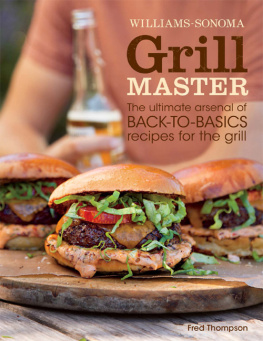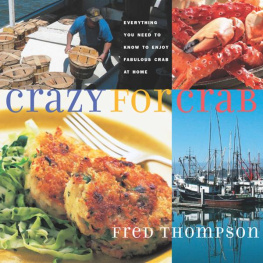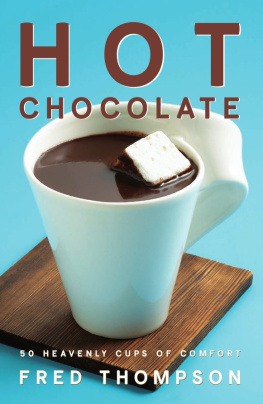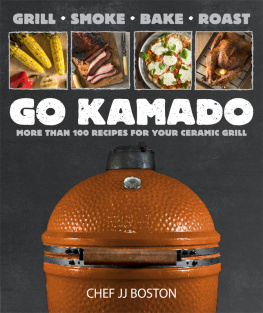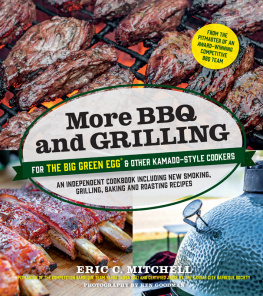Copyright 2014 by Fred Thompson
Published by
STACKPOLE BOOKS
5067 Ritter Road
Mechanicsburg, PA 17055
www.stackpolebooks.com
All rights reserved, including the right to reproduce this book or portions thereof in any form or by any means, electronic or mechanical, including photocopying, recording, or by any information storage and retrieval system, without permission in writing from the publisher. All inquiries should be addressed to Stackpole Books, 5067 Ritter Road, Mechanicsburg, Pennsylvania 17055.
Printed in the United States of America
10 9 8 7 6 5 4 3 2 1
First edition
Cover design by Wendy A. Reynolds
Cover images by the author
Library of Congress Cataloging-in-Publication Data
Thompson, Fred, 1953
The kamado grill cookbook / Fred Thompson. First edition.
pages cm
Includes index.
ISBN 978-0-8117-1468-6
eISBN 978-0-8117-6044-7
1. Outdoor cooking. 2. Barbecuing. 3. Stoves, Earthenware. I. Title.
TX823.T494 2014
641.5'78dc23
2014026689
To the next grillmaster:
Carter Bailey Wilkerson

Smoked Chicken Wings ()
Acknowledgments
A cookbook is never just the work of the person whose name is on the cover. While I get to play the role of author and fire-lighting expert, this work is a collaboration by many good folk.
Pam Hoenig, my editor, is the best. She brought this project to me and, through some difficult times with my mothers illness and eventual passing, guided me with love and patience to mold this book into what you are reading today. Weve worked on many projects together and Pam has always made me look better than I probably am. Thank you, Pam, for being, as you like to say, the silent partner.
The staff at Stackpole Books wrapped their arms around this book with excitement and vigor. Thanks to publisher, Judith Schnell, for her support of the project, and to the Creative Services department, and editorial assistant Tim Gahr for everything they did to bring this book out in record time. Stackpole has been a first-rate publisher to work with.
To make this cookbook a work that an owner of any kamado grill could use with confidence, I wanted to test the recipes and methods across several different brands of kamados. Primo, Grill Dome, Kamado Joe, and Bayou Classic made that possible by furnishing grills. Check out their websites. My neighbors loved the smells when all of these grills were fired up at the same time. I also received great counsel from Derald Schulz of Primo on all styles of kamados and especially the Primo Oval. Ashish Kohli, with Grill Dome, also added his expertise on the ways of kamado grilling. Thank you both for always taking my calls and keeping me on prudent paths.
I hope the photography for the book makes you hungry and want to light a fire. Kyle Wilkerson did much of the food styling, and I even let him take a turn or two with the camera. Much of the composition of the photos came from his creative mind and we made a great team and had lots of fun and good food. Kyle, being a chef, was also a grand sounding board for flavors and culinary ideas. My buddy and partner in Dinner Plate Productions, Drew Herche, also did some of the styling. He is the best at making a pizza and was amazed by the results that a kamado grill could achieve, so we made lots of them. His technical support and extra eyes were a huge help as I took the photos.
Belinda Ellis, prop stylist supreme, encouraged us to take chances with the photos. She also was invaluable with her professional knowledge of all things involving flour and baking, even while she was working on her own cookbooks.
As you read the introductions to the individual recipes, please take note of the many folks who shared recipes or inspired them. Kamado grilling is about regular people cooking great food at home, and without the input of my friends and colleagues, this book would be much less than what you see before you. Thank you all for sharing and keeping the fires burning.
Thanks to all the great writers, editors, and design folks who kept Edible Piedmont Magazine running while I worked on this project. I couldnt have finished this book without you. A special shout-out goes to executive editor Belinda Ellis and designer Melissa Peterson.
Thank you, Nikki Parrish, for suffering through another cookbook with me. Im a writer who doesnt type very well and Nikki has handled my word processing issues with grace and patience.
Thanks to my daughter, Laura, for giving me, and the world, my grandson, Carter. Im certain he will keep the grill hot for his generation. Also to Kathleen, for encouraging me early on in my career change into the food world that I love.

Spicy and Sweet Smoked Chicken Thighs ()
My mom was always confused about me not having a real job, but boy, would she swell with pride when a new book came out. Mom was a super cook and an even better eater, and I learned much from her. During the last year of her life she was always worried that I was spending too much time with her and not enough on this book and my other work. Mom, I wouldnt have had it any other way, and Im thankful for every minute we had. With much love, you will be missed.
Introduction
I f you were to mix the Chinese Qin Dynasty (221 to 207 B.C.), Japan in 400 A.D., American servicemen returning from the Pacific theater after World War II, and NASA, what do you think you would wind up with? A very utilitarian, multifunctional, some say funny-looking, elliptical cooking machine: the kamado. Notice I didnt say grilling apparatus, or smoking contraption, but cooking machine. Certainly you can grill and smoke on a kamado, but you can also roast, saut, steam, braise, and bake, all within the confines of the kamados dome.
The kamado finds its very early beginnings in the simple domed clay cookers of the ancient Chinese. It was then adopted by the Japanese, who gave the cooker the name kamado and probably first put a slotted grate into the dome. American GIs discovered the grill while stationed in Japan during the Second World War and, finally, it was the development by NASA of super ceramics for the space program that allowed the kamado grill to evolve into the superior cooking machine it is today, earning a well-deserved cultlike status among serious backyard culinary folk.
And I count myself as a convert. Over the past three decades, Ive cooked on every conceivable type of grill, written multiple books on all manner of outdoor grills and smokers, sat and jawed all night about flame-based cooking with great pitmasters, interviewed folks all over the country on their methods and recipes, and even dug pits for pig-pickings. I can say, without a doubt, that the kamado is my favorite way to cook outdoors. No, it isnt as easy as turning the valve on a gas grill, but what it lacks in immediate convenience, it more than makes up for in versatility andmost importantlydelicious, succulent food.
Moisturewhat most of us think of as juicinessis the carrier of the natural flavor of whatever it is we are cooking; its presence helps to spread that flavor across our taste buds. Ceramic cookers retain a foods moisture better than any other device Ive ever cooked on. Why? The design. The thick ceramic walls have better heat retention than any metal grill and the heft of the dome lid, coupled with the gasket, ensures a tight seal, creating a moist cooking environment inside. The draft system is centuries old and has changed very little over that time because it works, creating a swirling flow of air that bathes food in the trapped moisture instead of blasting it with dry heat. The dampers control temperature with unwavering precision. Ive had several models of kamado cookers maintain a steady 200 F, without any additional fuel, for eighteen hours. In all my years of smoking and grilling, Ive never seen another grill duplicate that feat.


